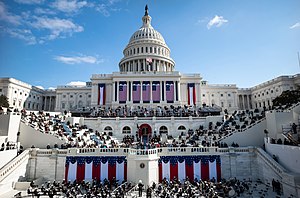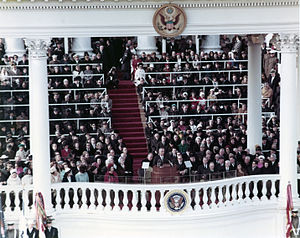
Back يوم القسم الرئاسي Arabic Investidura presidencial d'Estaos Xuníos AST ABŞ prezident inauqurasiyası Azerbaijani Indsættelsen af USA's præsident Danish Amtseinführung des Präsidenten der Vereinigten Staaten German Investidura presidencial de Estados Unidos Spanish روز معارفه (آمریکا) Persian Yhdysvaltain presidentin virkaanastujaiset Finnish Inauguration Day French השבעת נשיא ארצות הברית HE


Between 73 and 79 days after the presidential election, the president-elect of the United States is inaugurated as president by taking the presidential oath of office. The inauguration takes place for each new presidential term, even if the president is continuing in office for a second term.
The first inauguration of George Washington took place on April 30, 1789. All subsequent public inaugurations from 1793 until 1933 were held on March 4, except in 1821, 1849, 1877, and 1917, when March 4 fell on a Sunday and the public inauguration ceremony took place on Monday, March 5. Since 1937, it has taken place at noon EST on January 20, the first day of the new term, except in 1957, 1985, and 2013, when January 20 fell on a Sunday. In those years, the presidential oath of office was administered on that day privately and then again in a public ceremony the next day, on Monday, January 21. The most recent presidential inauguration was held on January 20, 2021, when Joe Biden assumed office.
Recitation of the presidential oath of office is the only component in this ceremony mandated by the United States Constitution (in Article II, Section One, Clause 8). Though it is not a constitutional requirement, the Chief Justice of the United States typically administers the presidential oath of office. Since 1789, the oath has been administered at 59 scheduled public inaugurations, by 15 chief justices, one associate justice, and one New York state judge. Others, in addition to the chief justice, have administered the oath of office to several of the nine vice presidents who have succeeded to the presidency upon their predecessor's death or resignation intra-term.
Since the 1981 inauguration of Ronald Reagan, the ceremony has been held at the west front of the United States Capitol facing the National Mall with its iconic Washington Monument and distant Lincoln Memorial. From 1829 through 1977, most swearing-in ceremonies had taken place on a platform over the steps at the Capitol's east portico. They have also been held inside the Old Senate Chamber, the chamber of the House of Representatives, and the Capitol rotunda.[1] The most recent regularly scheduled inauguration not to take place at the Capitol was the fourth inauguration of Franklin D. Roosevelt in 1945, which was held at the White House.
Over the years, various traditions have arisen that have expanded the inauguration from a simple oath-taking ceremony to a day-long event, including parades and multiple social gatherings. The ceremony itself is carried live via the major U.S. commercial television and cable news networks; various ones also stream it live on their websites.
When a president has assumed office intra-term, the inauguration ceremony has been conducted without pomp or fanfare. To facilitate a quick presidential transition under extraordinary circumstances, the new president takes the oath of office in a simple ceremony and usually addresses the nation afterward. This has happened nine times in United States history: eight times after the previous president had died while in office, and once after the previous president had resigned.
- ^ Williams, Brenna Williams (January 16, 2017). "Presidents change, Inauguration Day stays the same". CNN. Retrieved January 29, 2017.
© MMXXIII Rich X Search. We shall prevail. All rights reserved. Rich X Search